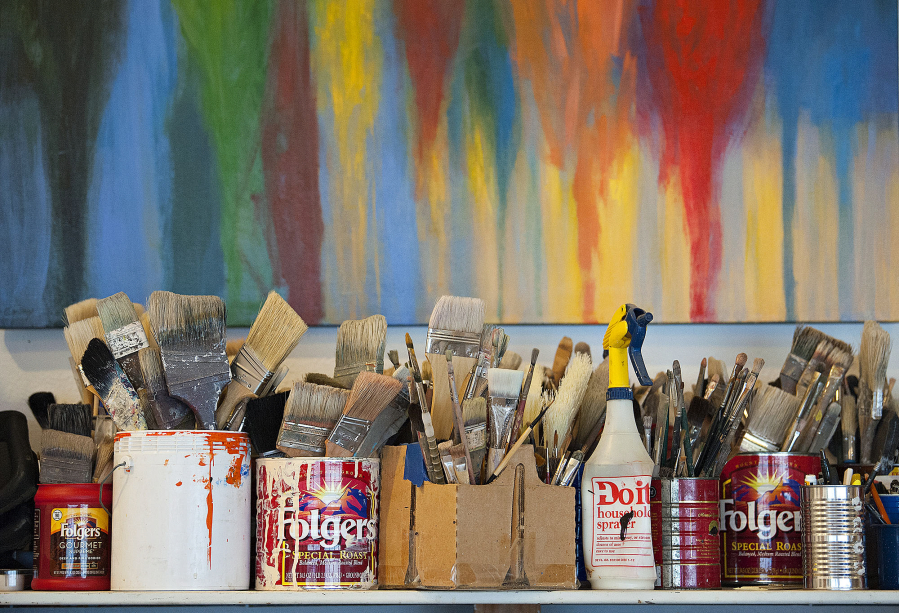To most of us, a rock is an inert, insignificant chunk of matter. It’s next to nothing. It sits there.
But to a rock, a human being is “nothing but a passing shadow,” said painter Don Gray. A human lifespan is the wink of an eye; the lifespan of a rock is “something unimaginably longer than our own,” he said.
Gray had this insight when pulling into the parking lot of Ladd Marsh, a natural area in Eastern Oregon. The parking lot boundary was made up of chunks of basalt that had been dragged off the landscape and arranged as a barrier, but Gray found himself thinking bigger: They weren’t always parking lot rocks, and someday they won’t be anymore.
“I sensed the life in these stones” and in the whole planet, he wrote in an essay about his recent work.
If you go
• What: “The Stone Retrospective” and “The View from Above,” exhibits by painter Don Gray.
• When: 8 a.m.-5 p.m., Monday through Firday, now through May.
• Where: Esther Building Art Space, 610 Esther St.; Rebecca Anstine Gallery, 1300 Franklin St., sixth floor.
• Artist’s talk: 6 p.m. April 19 at Esther Building.
• On the web: Dongraystudio.com
Gray photographed those stones, returned to his studio and got busy exploring the gap between realism and abstraction. The result was a stony still life in many sections — a meditation on the meaning and “metaphysics” of rocks.
You can see that sectional painting, and sample Gray’s many other intimate connections with the Earth, in an exhibit called “Stone Retrospective” that’s already up in the Esther Building Art Space at 610 Esther St. (on both floors — don’t miss the pieces upstairs).
It’s one of two simultaneous Gray exhibits; the other is “A View from Above,” at the Rebecca Anstine Gallery on the sixth floor of the Clark County Public Service Center, 1300 Franklin St.
Both buildings are open during regular business hours, 8 a.m.-5 p.m. Monday through Friday. Both exhibits will be on display through the end of May.
Also, Gray will give an artist’s talk about his work at 6 p.m. Wednesday in the Esther Building Art Space.
Blank page
Gray grew up in LaGrande, Ore., where he enjoyed the gift of knowing, from very early childhood, that he wanted to be an artist. His parents weren’t artistic, he said, but they were always supportive.
Maybe it all began, he said, when he accompanied his father to work at the local grocery. Dad would hand him a fat notepad, completely blank except for the words “Interior Grocery” across the top, and let him draw to his heart’s content. Mom saved all those sketches.
Decades later — after hunting for artistic inspiration in Arizona, Southern California and Union, Ore., before moving to Felida — the blank canvas is still Gray’s chief inspiration. When he starts with a definite idea or plan, he said, it limits him.
“Ideas are fine but you have to be willing to drop them,” he said. “If I have an idea and I try too desperately to cling to that idea, the work gets constrained and self-conscious.”
Therefore, he said, a typical beginning is: “I just dip my paintbrush and make a mark. Without a clue. It’s really exciting. And really anxiety-producing.”
Humbling
Gray may not have a clue when he begins, but he has lots of training and technique. He studied art and art education at Eastern Oregon University; he started exhibiting and selling realistic landscape paintings before he’d even graduated.
Then he got a job teaching high school art. He lasted one year.
“I hated it,” Gray admitted. “Teaching should be a dedicated profession. I knew I wasn’t doing justice to myself and to my students.” He met career teachers who felt exactly the same way, he added. “I said to myself, ‘I’m not going to end up like that.’ ”
It was the same with his artworks. Gray’s landscapes were popular but “predictable,” he said, and after many years and many exhibits, he felt he’d hit a plateau.
His lucrative career doing book illustrations and municipal murals felt like a compromise too.
About 25 years ago, Gray gave himself permission to stop copying reality. “I leapt into the unknown, and I’m still leaping,” he said on a recent morning while working in his studio on the next artistic phase, after rocks: rainbow trees. While these trees resemble Hawaii’s colorful eucaplyptus, Gray thinks of them as inhabiting another world.
Loosening up and getting away from realism was “a properly humbling experience,” Gray said. His devoted following didn’t love the change. “I guess you’ve got to do what sells,” was a common reaction.
But that’s the irony: Gray was following his vision, not sales. Many fans of his straightforward landscapes didn’t follow him all the way to abstract impressionism and the inner lives of rocks.
“Some stick with you, some don’t,” he said. “When you take a journey, not all your compadres are willing to take it with you.”
You can’t worry about that, he said. For Gray, being an artist means chasing “something important and intangible. You’ve got an itch to scratch. If your work doesn’t scratch that itch, you’ve got to move on.”




